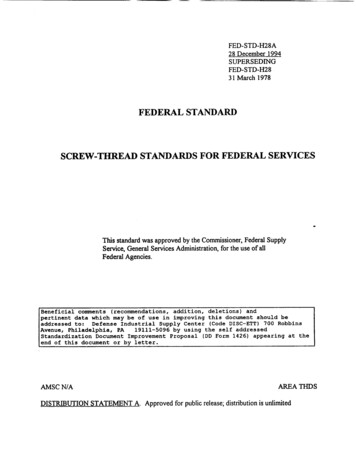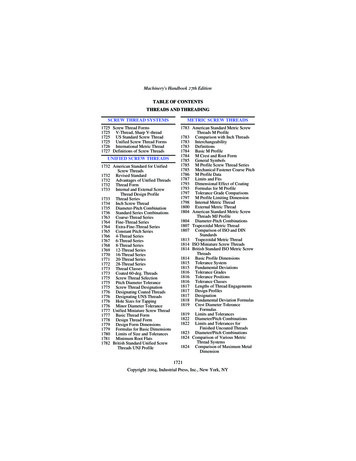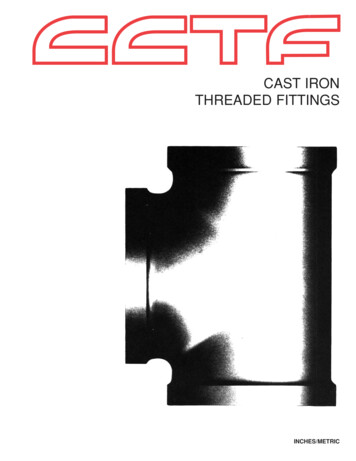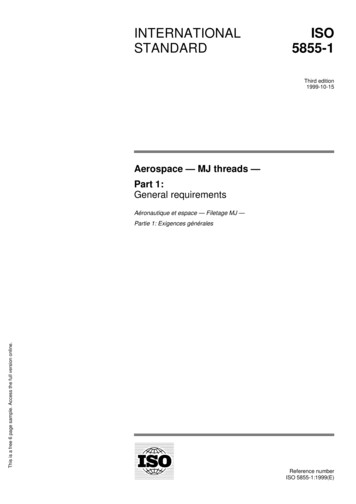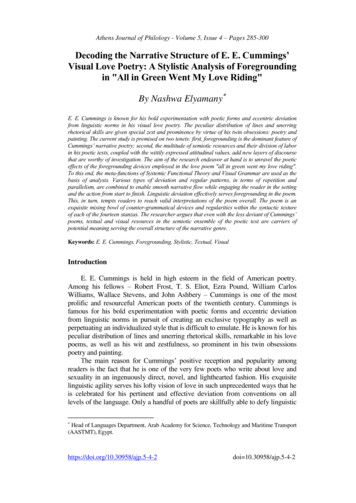
Transcription
PERSPECTIVESWeaving a Tapestry from Threads Spun by Geneticists:The Series Perspectives on Genetics, 1987–2008William F. Dove1McArdle Laboratory for Cancer Research, Department of Oncology and Laboratory of Genetics, University of Wisconsin–Madison,Wisconsin 53705ABSTRACT The Perspectives column was initiated in 1987 when Jan Drake, Editor-in-Chief of GENETICS, invited Jim Crow and WilliamDove to serve as coeditors of “Anecdotal, Historical, and Critical Commentaries.” As the series evolved over 21 years, under theguidance of Crow and Dove, the input of stories told by geneticists from many countries created a panorama of 20th-century genetics.Three recurrent themes are visible: how geneticists have created the science (as solitary investigators, in pairs, or in cooperative groups);how geneticists work hard, but find ways to have fun; and how public and private institutions have sustained the science of genetics,particularly in the United States. This article ends by considering how the Perspectives series and other communication formats cancarry forward the core science of genetics from the 20th into the 21st century.INSPIRED by Jan Drake, then Editor-in-Chief of GENETICS,James Crow and I (Figure 1A), both of the Universityof Wisconsin–Madison, founded the Perspectives column in1987. Dedicated to presenting vignettes of the history ofgenetics, the series created a veritable tapestry of stories ofthe science, as told by geneticists themselves. The loom onwhich these stories were woven stretched back throughthe 20th century. The two editors’ work was greatly facilitated by the fact that, between them, they had knownmany of the major figures of 20th-century genetics. Forexample, Crow, who was born in 1916, the year in whichGENETICS was founded, personally knew many of the geneticistsactive in population and evolutionary genetics in thatcentury. Crow’s research interests were broad, bridgingmutational issues from Drosophila (Mukai et al. 1972) tohumans (Crow and Abrahamson 1997), and important population genetic issues in evolution (Hiraizumi et al. 1960).Further, Crow taught general genetics at Wisconsin from1948 until his nominal retirement in 1986. Drake recognizedthe vast treasure of stories that Crow had developed, oncesaying “Someone should attach a recording device aroundJim’s neck to capture his stories!” A generation younger,I, in contrast, had extensive research experience in molecular biology and development, as heavily influenced byCopyright 2016 by the Genetics Society of Americadoi: 10.1534/genetics.116.1911551Address for correspondence: McArdle Laboratory for Cancer Research, University ofWisconsin–Madison, 1111 Highland Ave., Madison, WI 53705-2275. E-mail: dove@oncology.wisc.edugenetics, carrying out research on controlled replication inorganisms ranging from bacteriophage to protists to mammals (Furth et al. 1979; Moser et al. 1990; Burland et al.1993; Dove et al. 1998; Irving et al. 2014). My extensivecontacts in genetics reflect that range of interests. Fortuitously, from 1986 to 2006, I led Wisconsin’s Genetics Colloquium on current issues in research, bringing many of theleading geneticists in the world to the university’s campusat Madison to lecture and then engage in critical roundtablediscussions with the doctoral students on the evolving craft ofgenetics.Many a Perspectives article by an established geneticistwas triggered by an early report published in GENETICSwhen the salient issue was perceived only in outline. Eachyear, Crow and I would scan the table of contents ofGENETICS for articles published 5, 10, 15, 25, or 50 yearspreviously. We supplemented this process by noting theanniversaries of classics in genetics earmarked in A. H.Sturtevant’s history (Sturtevant 1965) and trying to recruitappropriate articles for Perspectives to commemorate those anniversaries. This rolling process generated an ever-flowingstream of invitations to geneticists who were present at thebirth of a topic and had come to preside over its maturation.Some of these writers were tapped when speaking at Wisconsin’sGenetics Colloquium. Other authors came into the foldfrom Crow’s and my networks of colleagues, centered inWisconsin but extending worldwide to Japan, China, England, Scotland, Belgium, Denmark, France, Germany, and theGenetics, Vol. 203, 1011–1022July 20161011
Figure 1 (A) Bill Dove, Jan Drake, andJim Crow at the 1992 GSA Meeting inSt. Paul, Minnesota. (B) Lucy Shapiroand Dale Kaiser at the fete for FrancoisJacob in Crete, 1991. (C) Charley Steinbergand Kirsten Fischer-Lindahl, Basel Instituteof Immunology, 1984. (D) NormanHorowitz, Ed Lewis, and Ray Owen inthe Caltech Athenaeum, 1998. (E)David Perkins, kneeling to study a poster at the 1992 GSA Meeting in St. Paul,Minnesota. (F) Welcome Bender andEric Lander deep in conversation, perhaps about chromosome walks in metazoans, at the 1992 GSA Meeting in St.Paul, Minnesota.Soviet Union. With both patience and gentle prodding, articles came forward “when time permitted.” Frequently an author found, not surprisingly, that the Perspectives articleattracted a broader response than the primary research report that triggered it. In the Crow–Dove collaboration, ithelped that we were within easy reach of one another,working in neighboring buildings on the campus. Shepherding so many articles involving authors around theglobe led to occasional lapses. Our good working relationship allowed us to move forward with a simple mea culpa(Dove and Susman 2012).Overall, the 1987–2008 Perspectives series is neither ahistory nor a textbook of genetics. Instead, it constitutesan ensemble of stories varying in technical detail. Thestories are personal, however; many sense the startingpoint and creative pulse of the geneticist by which thescience of genetics is generated and regenerated. Here,I choose to comment on three recurrent themes: how geneticists have functioned as solitary investigators, in pairs, orin cooperative groups; how geneticists work hard but find ways1012W. F. Doveto have fun; and how public and private institutions have sustained the science of genetics, particularly in the United States.Most of the cited articles in what follows were contributions toPerspectives. Each selected comment represents a small sampleof the original article, and the cited articles are an arbitrarysubset of the 1987–2008 Crow–Dove Perspectives series. Theinterested reader can gain access to the collection of Crow-DovePerspectives essays in reverse chronological order on theGENETICS website: ectives.How Geneticists Have FunctionedAs solitary investigatorsMuch of the popular perception of scientific progress istied up with the Great Man theory of history, namelyextraordinary individuals who were major but largelysolitary pathfinders. Examples that come to mind includeGalileo, Newton, Darwin, Pasteur, Einstein, and, in genetics, Mendel and McClintock. There are, however, other
exemplary individuals of this class who are far less wellknown. Tom Nagylaki, for example, elucidated the formative body of theoretical research carried out in apparentisolation by the French scholar Gustave Malecot:Seldom does a doctoral dissertation substantially advance its field. Nevertheless, just such a rare dissertation,Theorie mathimatique de 1’hiriditi mendilienne generalisie, was submitted fifty years ago, to the Faculty of Sciences of the University of Paris, by Gustave Malecot . . .Despite the breadth, depth, originality, power, and elegance of the contributions of this great French theoretical population geneticist, much of his work is knowneven now only to a small minority of researchers in hisarea (Nagylaki 1989).In a similar vein, but in an example in which the historyof genetics collided with a larger force in political history,Jim Crow contrasted the story of the Russian plant geneticist Vavilov with that of his Japanese contemporary Kihara.Each created comprehensive collections of wild varieties oftheir plant species of interest. Vavilov, however, becameentangled with the political force of Lysenkoism unleashedby Stalin.On January 26, 1943, Nikolai Ivanovitch Vavilov, nearstarvation, died in a Soviet prison hospital. He was 55, atwhat should have been the peak of his career . . . Geneticswas fated to be caught up in the two most devastatingEuropean dictatorships of the century. Hitler’s notoriousracist policies deprived Germany and the world ofsome of our greatest minds and clouded human geneticsfor decades. Stalin, by supporting Lysenko’s bizarreLamarckism, set Soviet genetics a generation behind.[Hermann Muller] had spent four years in Russia, from1933 to 1937, at Vavilov’s invitation. He had gone therewith high hopes for an expanded, well supported genetic research program and had come back thoroughly discouraged. Geneticists had been disappearing—18 ofVavilov’s staff members were arrested between 1934and 1940—and the program was devastated . . .[Vavilov’s] downfall came from the ambitious TrofimLysenko, who . . . had attracted [Stalin’s] attention withthe technique of vernalization, by which cold treatment ofseeds altered development in a way said to hasten maturityand increase yields. Vavilov actually promoted Lysenko bypraising these results. By this time Vavilov was being criticized for failing to produce the hoped-for increases in agricultural productivity. His method of collecting wild relativesof cultivars from around the world would yield only slow(but certain) improvement. Lysenko, with his naive Lamarckian views, promised quick results. The debates werevigorous and even Muller got into the act . . .[asking] whathope there could be for a proletarian revolution when thepoor had suffered generations of bad environments,which on a Lamarckian interpretation would have ruinedtheir genetic potential. The answer is not recorded (Crow1993).Another example of the solitary pioneer was Leo Szilard,who, after critical contributions to atomic physics, gainedprominence in biology, playing a role in steering Jacoband Monod to consider a “double-negative” model for theinduction of b-galactosidase, instead of simple positive induction. Werner Maas described Szilard’s career as that of a“lone wolf.”[Szilard and his junior colleague Aaron Novick] begantheir entry into biology by taking the Phage Course at ColdSpring Harbor in 1947, which at that time was taught by MaxDelbruck . . . Szilard spent a great deal of his time visitingother scientists in the quest for obtaining information aboutquestions that interested him. He was very purposeful during these visits. As an example, during a party in BernardDavis’s apartment . . . Szilard suddenly appeared . . . [He]took over a bedroom and invited each guest, in turn, infor a private chat, quizzing them on their latest work andfindings, suggesting new experiments and novel interpretations, and reporting how these might relate to the work ofothers (Maas 2004).The genetics of Esherichia coli, initiated by Josh and EstherLederberg, provided a platform from which Julius Adlercarved out his own solitary niche. Julius described an epiphany that occurred while he was studying the general biologyof micro-organisms with C. B. van Niel at the Hopkins MarineStation:But my greatest accomplishment was to make a decisionon my research subject as an independent scientist. I wantedto study behavior, but which behavior of which organism?The Marine Station has a grand library with journals datingback to nearly the beginning. There I found the ‘ancient’(1880s) publications of Wilhelm Pfeffer on the chemotacticbehavior of bacteria. I decided that was it! (Adler 2011)Sandy Parkinson has described the beginnings of Julius’sadventure:Motile microorganisms exhibit surprisingly sophisticatedsensory behaviors . . . These behaviors came to light in thepioneering work of Engelmann, Pfeffer, and others in the1880s . . . but were largely overlooked until Julius Adler . . .initiated work on the chemotaxis system of Escherichia coli. . . Adler chose E. coli primarily for the genetic methods thatcould be brought to bear on the problem, reasoning that theflow of sensory information through stimulus transductioncomponents should be amenable to genetic dissection muchlike a conventional biochemical pathway . . . The mutantsisolated during those early days of E. coli chemotaxis werewidely disseminated to workers in the chemotaxis field andhave served to define most of the known components of thesensory transduction machinery: receptors, transducers,signaling elements and flagellar switching components . . .[We] owe special thanks to Julius Adler for having the foresight to pick an organism with good genetics (Parkinson1987).Adler’s (2011) memoir “My Life With Nature” gives abroad view of the ways in which this niche has grown fromits solitary beginnings.The Perspectives series provides several personal stories inwhich a solitary investigator created a new niche by reinvention of one’s self. Lee Hartwell made the transition from themolecular analysis of macromolecular synthesis in bacteriato his pioneering study of the cell cycle, thanks to yeast genetics (Hartwell 1991). His overview of his studies of genescontrolling the cell cycle further illustrated reinvention. ToPerspectives1013
understand the uniform terminal phenotype that definedeach of his extensive collection of “cell cycle (cdc) mutants”in Saccharomyces cerevisiae, and the deduction of the dependent pathway of the action of the genes involved, Hartwelland Ted Weiner proposed that:It is likely that the dependent relations between manyevents of the cell cycle are due to . . . controls . . . We havetermed these control points in the cell cycle ‘checkpoints’(Hartwell 1991).Thus, two decades after the isolation of the first cell cyclemutants, investigators began to turn attention to checkpoints.Gerry Fink illustrated a different mode of reinvention: takingthe lessons learned from yeast genetics to develop the geneticanalysis of plant biology in Arabidopsis (Fink 1988). In his“Notes of a Bigamous Biologist” he explained how he madethe transition from a fast-growing to a slower species:Although the duration of the Arabidopsis life cycle seemsat first interminable to the microbial geneticist, it becomesless of a psychological shock as one learns to initiate experiments in parallel rather than in series. Once this newrhythm has been acquired, the results arrive in the rapidsuccession to which microbial geneticists are accustomed(Fink 1988).In contrast to the isolation of Vavilov by political forces,Jim Crow’s final Perspectives article on Edmund Just (1883–1941), “Just and Unjust,” illuminated the institutional andcommunity prejudice of the 1930s that isolated this extraordinarily able biologist. Crow wrote:Just . . . was one of the greatest biologists of the early 20thcentury, but being AfroAmerican, he never had a position thatpermitted full development of his research talent . . . Just wasa superb technician and extremely careful worker. He setrigorous standards for experimentation and was openly critical of experiments that did not meet his standards. Furthermore, he trusted his observations and did not hesitate topoint out disagreements with others. The most notable ofthese was a difference with [his Woods Hole colleague]Jacques Loeb . . . Loeb had argued that the development ofthe egg was initiated by two steps, a cytolysis, induced in thelaboratory by butyric acid, followed by a quenching producedby hypertonic sea water. Just showed that, with careful attention to concentrations, sea water alone was sufficient.Unfortunately for Just, Loeb’s earlier friendship changedto enmity. One of the few opportunities that Just had [tomove from his teaching position at Howard University] for aposition in a research environment occurred in 1923. Justwas being considered for a position at the Rockefeller Institute for Medical Research. Naturally Loeb’s advice wassought and his reply left no uncertainty.[Frank] Lillie [of the University of Chicago and WoodsHole] must have known Just better than any other Americanscientist . . . In his . . . restrained way, he said ‘An element oftragedy ran through all Just’s scientific career due to thelimitations imposed by being a Negro in America . . .Thenumerous grants for research did not compensate for failureto receive an appointment in one of the large universities orresearch institutes . . . In Europe he was received with universal kindness, and made to feel at home in every way . . .That a man of his ability, scientific devotion, and of such1014W. F. Dovestrong personal loyalties as he gave and received, shouldhave been warped in the land of his birth must remain amatter for regret.’ (Crow 2008)Jim Crow once testified that “A person with my name shouldknow something about the status of African-Americans inthe United States.” His article on Just combined this lifelongcommitment with his appreciation of the exceptional solitary scientist.In pairsIndeed, the mode of the solitary investigator, plowing aunique, distinctive furrow in isolation, is far from the rulein the history of genetics. Far more striking and common is thefact that progress is often made by pairs of investigators. Thecreative partnerships of Watson and Crick, Meselson andStahl, Brenner and Crick, Jacob and Monod, and Crow andKimura are well-known examples. Several articles in the Perspectives series display important but more nuanced examplesof what we might well call the “Power of Two.”The Mom and Pop Editorial Shop: Indeed, the operation ofGENETICS during much of the Crow–Dove era involved thecomplementary efforts of Jan and Pamela Drake. In his sayonaraas Editor-in Chief, Jan painted a picture of the intimacy involvedin what came to be called the ‘Mom and Pop Editorial Shop’:. . .authors all over the world could be harassed directly fromour office at any hour of the day. Some authors retaliated byphoning us during European or Australian working hours. Thedistant ring of the editorial office phone in the middle of ournight was uncannily like a baby’s cry in its ability to rouse usabruptly and fully. Once awakened, we would often stay in theeditorial office, secure in the knowledge that no author couldsee us working in our pajamas (Drake 1998).Fostering Neurospora: Examples that were particularlyprominent early in the century involved husband–wife combinations in which one member of the creative pair, commonlythe wife, held an academic position of lower stature. Joshuaand Esther Lederberg, mentioned earlier, were one example.Another was that of David and Dorothy (Dot) Perkins, whotogether established a focal point for the development ofNeurospora genetics. Rowland Davis described their partnership:[Dot’s] involvement with David’s genetic studies deepened with time, yet her publications reflect the independence with which she worked. She sought increasingly totie up loose ends . . . It is a tribute to both David and Dot thatDavid did not co-author publications that were truly herwork, nor did either one hesitate to co-author articles onwhich they clearly collaborated (Davis 2007).Cell biology meets molecular genetics: Carolyn Silflow andPete Lefebvre represent an academically coequal husband–wife pair. Their research pairing in the 1980s reflected theemergent necessity in that era to combine expertise in the
genetic analysis of cellular phenotypes with sophisticatedmolecular analysis of the genotype. The rich biology of theprotist Chlamydomonas invited study of motility at a molecular level. Silflow and Lefebvre combined mutant analysisbased on motility phenotypes with genetic mapping basedon restriction site polymorphisms in natural isolates (Ranumet al. 1988; Lefebvre and Silflow 1999):[the scarcity of RFLPs for many cloned probes . . . wassolved] when an undergraduate student in our laboratories,Christian Gross, discovered a field isolate of Chlamydomonas (strain S1-D2) that is completely interfertile with thelaboratory strains, but that shows an exceptionally highfrequency of RFLPs . . . (Lefebvre and Silflow 1999).Lefebvre and Silflow have amplified their Power of Two bytheir effort with others to create a self-sustaining Chlamydomonas community for the study of the cytoskeleton, basalbody, cellular motility, and photosynthesis. They summarizedthis group process in their Perspective:Starting 20 years ago with a small roomful of enthusiasts atthe Chlamydomonas/Euglena session, held annually for part of1 day at the American Society for Cell Biology meetings, theChlamydomonas meetings have grown to attract more than200 participants every 2 years (Lefebvre and Silflow 1999).Microbes pair to simulate metazoan development: Sometimes, the Power of Two pertains as much to the subject matteras to the investigators. One theme in metazoan development islineage determination involving asymmetric cell division, whilea contrasting theme is the creation of cellular differences throughcell–cell interaction. The interaction between Lucille (Lucy)Shapiro and Dale Kaiser illustrates a choice of a complementarypair of microbial species to illuminate the two sides of this contrast (Figure 1B). Working in parallel at Stanford, Lucy and Dalehave investigated these basic issues in developmental biologythrough the high-resolution lens of the molecular genetics ofmicrobes. Lucy investigates the mechanisms and consequencesof asymmetric cell division in Caulobacter, summarizing an earlystage in these studies in her Perspectives article with Bert Ely:A critical part of our strategy to dissect Caulobacter’s temporaland spatial control of development was the establishment of asystem for genetic analysis. Accordingly, one of the first objectives . . . was the isolation of a generalized transducing phagewhich would facilitate exchange of genetic material betweenCaulobacter strains (Ely and Shapiro 1989).Dale investigates multicellular co-operation in Myxobacter,connecting these studies back a century to Roland Thaxter (Kaiser1993). His interests expand the notion of the Power of Twoby seeking commonality at a higher biological level betweenprokaryotic myxobacteria and eukaryotic cellular slime molds:Slime molds and myxobacteria are found in the samehabitats, and are often isolated from the same soil samplesby enrichment culture. Both feed on bacteria in the soil . . .The observed evolutionary convergence of these two disparate groups is presumably a consequence of natural selectionin a common habitat . . . Perhaps there are also rules aboutthe way development and morphogenesis are regulated forreliability in relatively harsh or changing environments. Useof cellular oscillators revealed by traveling waves and theexpression of genes in batteries, triggered by different extracellular signals, are cases in point. Comparisons of eukaryotesand prokaryotes may give insights that would come fromneither examined alone (Kaiser 1993).Meiosis in pairs: The magic created by an interaction betweentwo independent investigators extended around the world in alandmark investigation of meiosis in Drosophila by Larry Sandlerand Dan Lindsley. They normally operated at the distancebetween Seattle (Sandler) and San Diego (Lindsley), butgot together for a joint sabbatical in Rome during which theyisolated a series of Drosophila mutants affected in the processof meiosis. Scott Hawley has described how their initiative was:one of the earliest examples of a systematic search for, andstudy of, mutations affecting a complex regulatory process inhigher eukaryotes. The decision to search for meiotic mutations in natural populations was based on the assumptionthat recessive mutations would be found as heterozygotes innatural populations at a frequency equal to the square root oftheir mutation rate, a frequency high enough to be detectedin screens (Hawley 1993).Mentoring new leaders for molecular immunology: Thefinal example of the Power of Two illustrates a rare mode ofinteraction that normally flies below the radar of histories ofscience. Charley Steinberg published only rarely but served asmentor to many of the talented junior members of Niels Jerne’sBasel Institute of Immunology who became leaders in molecularimmunology (Figure 1C). Under Charley’s guidance, these mentees solved several of the major problems in the somatic geneticsof the adaptive immune system. As summarized by Gillian Wuand Kirsten Lindahl, one of his mentees, Louis Du Pasquier, said:A mentor listens to the babblings of a scientist trying tofigure out the data. Charley would hand us a chalk and say:‘Start from the beginning, I am a simpleton, I don’t knowanything about this area, explain it to me.’ And by explaining it to him, you would begin to understand it yourself. Asilent Charley made you think . . . Charley helped me when Iwas confronted with strange results—explaining to me whythe bacteriophage I used was likely not the one whose namewas written on the label . . . (Wu and Lindahl 2001)Gillian and Kirsten also quoted Charley near the end of hislife:If I had it to do all over again, I would not change. Iprevented a lot of atrocities in my day. I have nothing toapologize for (Wu and Lindahl 2001).In co-operative groupsNeither solitary workers nor significant pairs, however, arethe whole story of progress in genetics. A major contribution toPerspectives1015
the substratum on which 20th-century genetics developedwas the creation of open co-operative groups of investigators.The logistical barriers to genetic analysis in maize wereaddressed early by this strong spirit of co-operation. Lee Kass,Christophe Bonneuil, and Ed Coe described the birth of thefirst such group:At the 1932 International Congress of Genetics held inIthaca, New York, Rollins Adams Emerson . . . gave anopening address titled, ‘The Present Status of Maize Genetics.’ In his introduction he declared, ‘I cannot refrainfrom noting here a very real advantage experienced bystudents of maize genetics . . . I am aware of no other groupof investigators who have so freely shared with each othernot only their materials but even their unpublished data.The present status of maize genetics, whatever of noteworthy significance it presents, is largely to be creditedto this somewhat unique, unselfishly cooperative spiritof the considerable group of students of maize genetics.’(Kass et al. 2005)The paradigm established by the maize group has beenreplicated by a number of organism-specific groups, eachholding regular conferences as discussed above for Chlamydomonas. The success of these organism-specific groups hasgarnered significant conference support from the GeneticsSociety of America (GSA) and research support from theNational Institutes of Health (NIH) and the National Science Foundation (NSF). Perhaps the epitome of group action has been that involving the nematode Caenorhabditiselegans. As Jonathan Hodgkin summarized in his article“Early Worms”:A final advantage . . . has been the establishment of agroup of enthusiastic and dedicated workers. All ofthe early genetic work was due to [Sydney] Brenner,but the appeal of the system was such that moreand more disciples began to accumulate. As with themutant strains, so with the scientists: almost every workerin the field has an intellectual pedigree that traces back to asingle source. Moreover, most of the early workers had acommon background in either bacterial or phage genetics especially T4. . . The ‘phage’ influence colored a lot of theearly work, for example, the emphasis on powerful selections and rare events, the usefulness of conditionalmutants . . . and the need for long-term storage (Hodgkin1989).The spirit of sharing strains goes beyond the organismspecific co-operative groups. In his article, Frank Stahldescribed the 30-year history of Robin Holliday’s molecular model of genetic recombination. The model was challenged with experiments made possible by strains of arange of organisms exchanged among geneticists. Stahlconcluded:The junction is there, [except . . .]; mismatch correctioncontributes to conversion, [except . . .]. That’s an impressive record, really. Robin’s model was the lightning rodfor 30 years of research, and its central assumptions,though modified, have survived every strike. Congratulations, Robin!” (Stahl 1994)1016W. F. DoveThis story illustrates ways in which geneticists interactacross organisms on issues that lie at the core of the science.I shall return to this point at the end of this essay.How Geneticists Work Hard Yet Have FunJim Crow’s creative life gives a vibrant example of the synergybetween working hard and engaging fully in a hobby. Froman early age, Crow’s consuming hobby was music. He described to me why he had settled upon playing the viola:“Because string quartets are always looking for a violist.”Hartl and Greenberg Temin described Crow’s lifelong involvement with music, telling a tale from his graduate daysthat illustrates this fun-loving spirit:A memorable incident from Crow’s [graduate student]days in the University [of Texas-Austin] Orchestra meldedhis musical and scientific activities. One day he left his violain the lab, so that he could pick it up later on his way to aconcert. One of his lab mates took the opportunity tostealthily place thousands of anesthetized fruit flies insidethe viola, timing it so that as Crow began to play at theperformance, the flies gradually awakened and flutteredup out of the F-holes. He often recounted this as ‘one ofthe diabolically cleverest jokes that anyone ever perpetrated.’ (Hartl and Greenberg Temin 2014)The powerful influence of a life-long passionate interest inan activity outside the laboratory is also illustrated in the lifeof Guido Pontecorvo, which spanned the destruction of Jewishlife by Fascism in Italy, World War II, and the migration ofscientists to the United Kingdom and the United States. Hisgenetics research started in Edinburgh in 1940 with HermannMuller (who had escaped from Stalin’s USSR to Edinburgh),and then
Wisconsin–Madison, 1111 Highland Ave., Madison, WI 53705-2275. E-mail: dove@ oncology.wisc.edu Genetics, Vol. 203, 1011–1022 July 2016 1011. Soviet Union. With both patience and gentle prodding, arti-c
